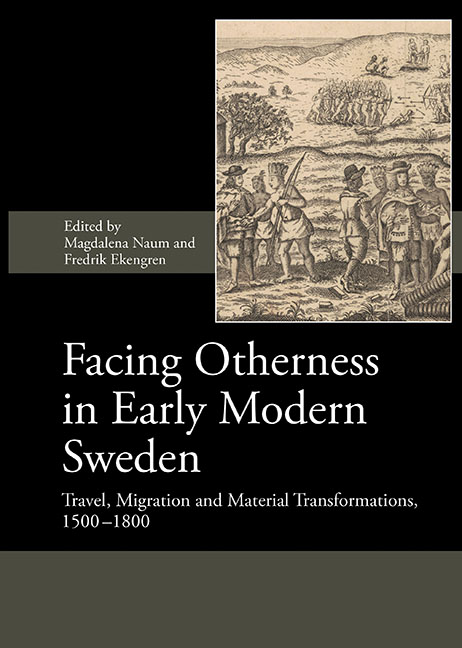Book contents
- Frontmatter
- Contents
- List of Illustrations
- List of Contributors
- Preface
- List of Abbreviations
- I Material Transformations
- II Migration and Neighbourly Interactions
- III Overseas Travel
- Introduction
- 13 “How It Would Be to Walk On the New World with Feet from the Old”: Facing Otherness in Colonial America
- 14 Inscribing Indigeneity in the Colonial Landscape of New Sweden, 1638–1655
- 15 Men You Can Trust? Intercultural Trust and Masculinity in the Eyes of Swedes in 18th-Century Canton
- 16 The Barbary Coast and Ottoman Slavery in the Swedish Early Modern Imagination
- 17 A World of Distinctions: Pehr Löfling and the Meaning of Difference
- IV Conclusions
- Index
14 - Inscribing Indigeneity in the Colonial Landscape of New Sweden, 1638–1655
from III - Overseas Travel
Published online by Cambridge University Press: 23 July 2019
- Frontmatter
- Contents
- List of Illustrations
- List of Contributors
- Preface
- List of Abbreviations
- I Material Transformations
- II Migration and Neighbourly Interactions
- III Overseas Travel
- Introduction
- 13 “How It Would Be to Walk On the New World with Feet from the Old”: Facing Otherness in Colonial America
- 14 Inscribing Indigeneity in the Colonial Landscape of New Sweden, 1638–1655
- 15 Men You Can Trust? Intercultural Trust and Masculinity in the Eyes of Swedes in 18th-Century Canton
- 16 The Barbary Coast and Ottoman Slavery in the Swedish Early Modern Imagination
- 17 A World of Distinctions: Pehr Löfling and the Meaning of Difference
- IV Conclusions
- Index
Summary
In the narrative of New Sweden, the indigenous inhabitants are often styled as “the others”, sharing only an ephemeral presence alongside the Swedish colonists. Similarly, the interpretations of landscape and settlement patterns are often rooted in ideas of European hegemony. This chapter asks what would happen if we instead acknowledge this region as socially constructed, and inscribe the Native American population in the landscape and the history of New Sweden, using both archaeological and literary sources. Mapping both Native American and Swedish sites, this chapter discusses the issue of cohabitation and shared space in the Lower Delaware valley.
A LANDSCAPE BETWEEN NATURE AND CULTURE – A LANDSCAPE BETWEEN PREHISTORY AND HISTORY
The encounter between the settlers of New Sweden and the indigenous population in 17th-century America has for a long time produced a somewhat contradictory image. On the one hand, Swedish historical accounts appropriated the widespread European notion of the American landscape as virgin, pristine and bountiful, full of riches and potential resources, but virtually devoid of culture or civilization. It was characterized, in writing as well as in visual representations, as a natural landscape rather than a cultural one, thus legitimizing and manifesting territorial annexation. This notion has been appropriated into academic research as well, whereby maps of colonial America carefully outline the territorial extent and claims of New Sweden in relation to the other colonial powers, but rarely include the Native American communities who shared the political landscape. Accordingly, an interpretative model is perpetuated based on European hegemony, where the Swedes are envisioned as pioneers who transplanted all the institutions and material traditions of home on to the wilderness, while the Native Americans are relegated to the borderlands or margins of colonial landscapes (physical as well as mental) and given the role of “the others” in the narrative of New Sweden. On the other hand, we have several 17th-century Swedish sources that acknowledge the Native Americans as rightful owners of the land and emphasize the close relationship and dependency between the Swedes and their indigenous neighbours, though their physical presence in the landscape is noted or implied rather than detailed. These accounts are in turn often highlighted by the few, primarily historical, studies that have sought to inscribe indigeneity into the colony of New Sweden.
- Type
- Chapter
- Information
- Facing Otherness in Early Modern SwedenTravel, Migration and Material Transformations 1500–1800, pp. 261 - 288Publisher: Boydell & BrewerPrint publication year: 2018



